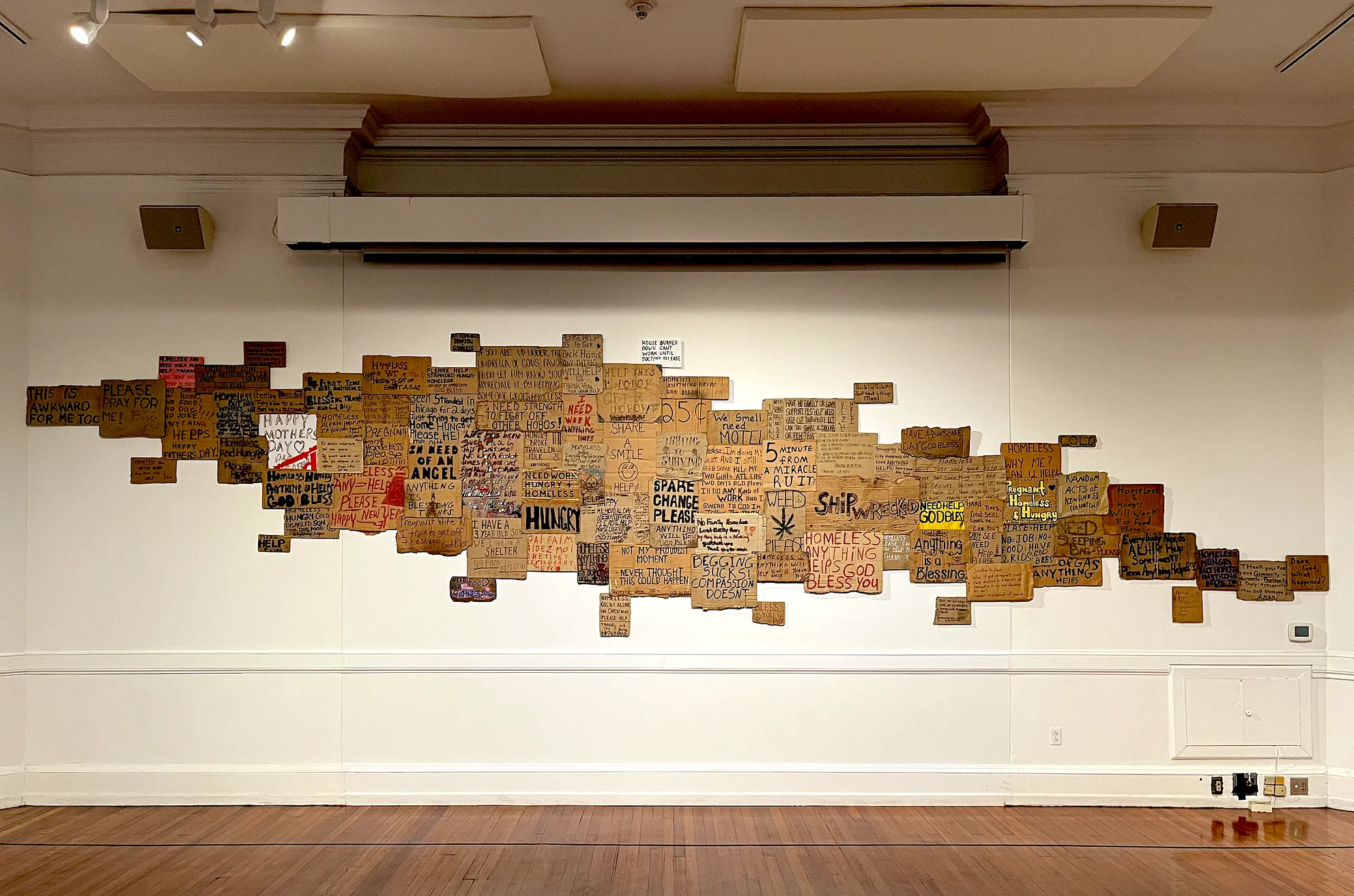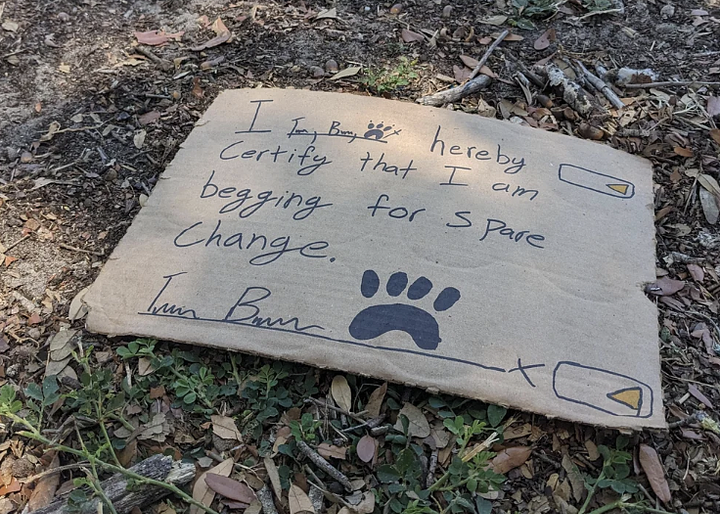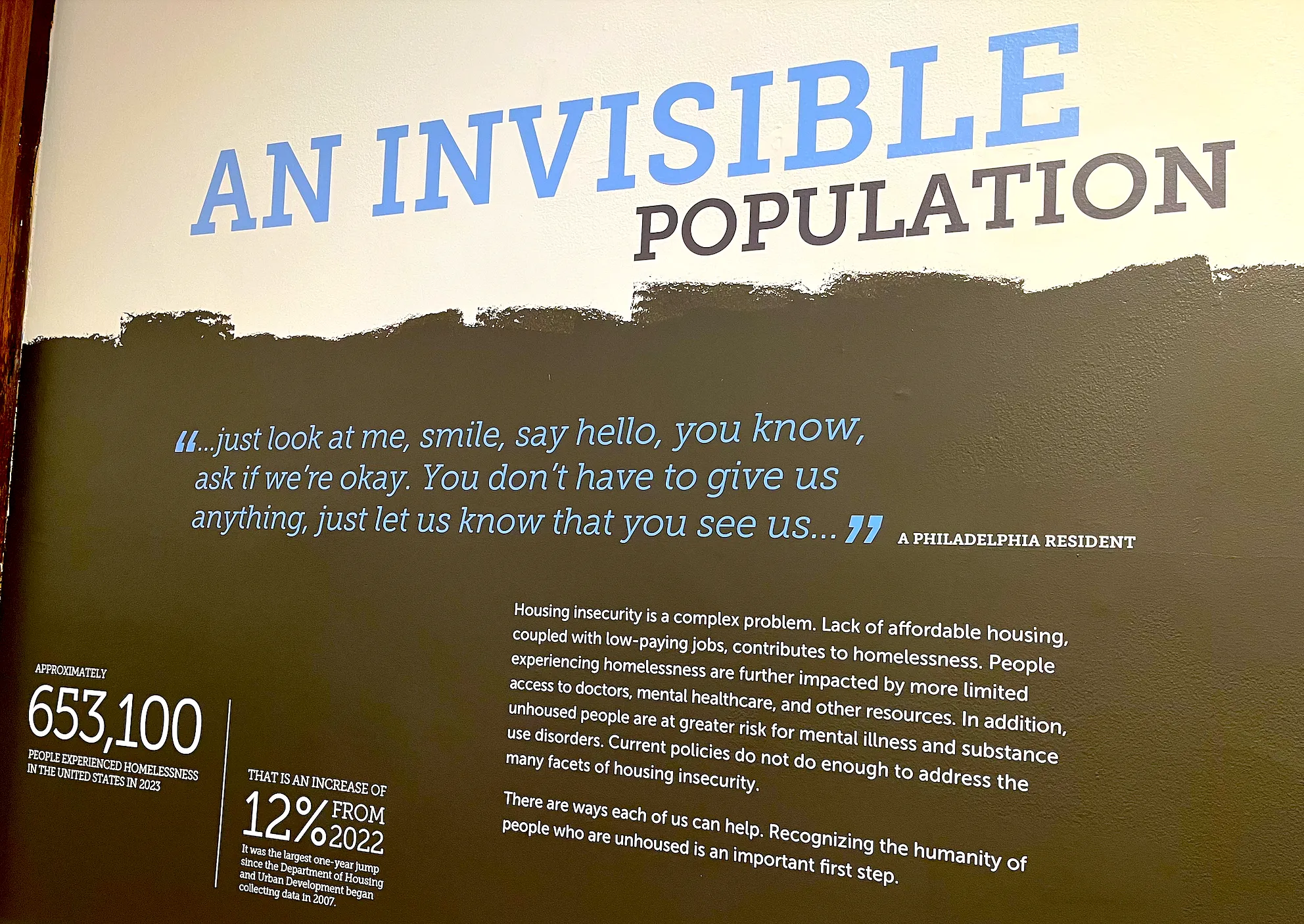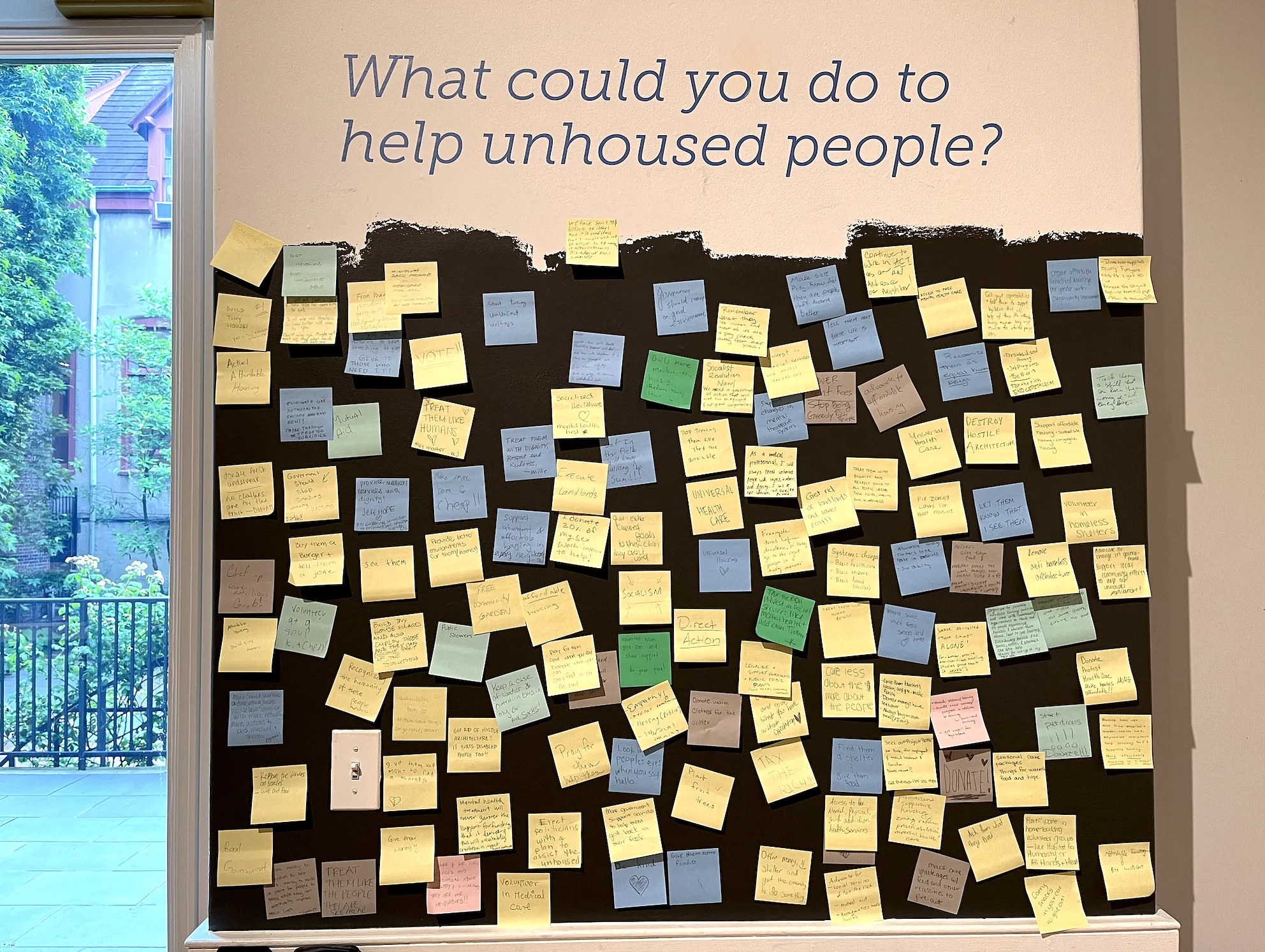Unhoused: Personal Stories and Public Health
The Mutter Museum
19 S. 22nd St.
Philadelphia
I walked by three people camped out on the few blocks of sidewalk between my bus stop and the Mutter Museum — where I paid $20 to stare at a collage of cardboard boxes.
The cardboard boxes were one part of Unhoused: Personal Stories and Public Health, a current Mutter exhibit which seeks to explore — and “humanize” — homelessness.
Unhoused: Personal Stories and Public Health seemed by title alone a meta attempt at taking on the question of “how to humanize.” The exhibit is the first that Mutter Director Kate Quinn has given the go-ahead since she took over the museum in 2022 and stirred the pot with her vision to reorient the museum’s focus to “health, not death,” amid a crunch of critiques about the museum’s collection and presentation of human remains. (Read more on that in the Inquirer, here.)
Most of the exhibit does little if any of that in a meaningful way, leaning toward cliched, shallow statements and visual tropes that might make visitors feel better about themselves while reinforcing our inability to wrestle with deeper roots of the problem.
The cardboard boxes — the latest installation in an ongoing project by the artist Willy Baronet called “We Are All Homeless” — offer perhaps the one powerful antidote to the show’s, and the Mutter’s, failed approach. It turns out that faceless messages convey more humanity than all the close-up facial portraits displayed elsewhere in the exhibit.
It was maybe ironic that a bunch of cardboard signs separated from their creators and in some ways credited to an artist and professor who turned four TED talks and a career out of essentially collecting cheap art was by far my favorite part. That had to do with not just how to tackle poverty-related problems in a museum setting, but about how the Mutter itself is wrestling with fundamental questions about art and exploitation.
Mutter-ing About "Humanization"
I had never visited the Mutter Museum before, but I had read plenty of articles debating their controversial collection displayed inside The College of Physicians of Philadelphia.
Amid the amped-up spotlight on lethargic or altogether nonexistent efforts from academic institutions and museums to repatriate looted Indigenous remains and artifacts, the Mutter has stood out like a psoriasis-smothered thumb. That’s not only because the Mutter is still in the process of returning their fair share of Native American belongings back to tribes. It’s also because as a body devoted to public health education and exposing the public to ancient humanity, disease and deformity, the Mutter has been a target for angry and sometimes loaded critiques about post-mortem consent, modern spectacularization and cancel culture.
In other words, the famed and beloved-by-many Mutter Museum has had a complicated reckoning in recent years over a classic question: How can old fashioned institutions start telling diverse stories — without dehumanizing the people behind them?
Here’s the thing: When it comes to homelessness, the only stories I ever seem to see are justified and qualified as “humanizing.” Humanization is often helpful when it comes to sympathizing for the other side. But it’s not always the answer to finding workable common ground in a political battleground. And right now, with a Supreme Court Case ruling still pending as to whether or not it’s cruel and unusual punishment to fine or jail people for sleeping outside when they have nowhere else to go, a battleground is exactly what housing is. Philly is no exception to the national disaster, with a huge proportion of the city’s unhoused population even more lost than usual following Mayor Cherelle Parker’s encampment sweep in Kensington back in May.
The Faces


So I get tired of fancy photo portraits of human beings experiencing homelessness when they’re framed in museum hallways as activism or education. And that’s exactly what the other side of the Mutter’s exhibit was. Predictable.
In the single-room show dedicated to a complicated problem, there is a wall of black and white photos, all of unhoused individuals as captured by professional fashion photographer Leah den Bok, who was just a teen when she took most if not all of the photos seen at the Mutter. Directly across from it is the cardboard collage, showcasing a diversity of penmanship, personhood and philanthropic fundraising strategy.
The portraits, tessellated into a stylistically uniform family-tree-style mural, are beautiful, bold and accompanied by a book full of paragraphs recalling brief, first-person interactions with each of the individuals pictured on the larger wall. Some of the images are tragically startling — like a photograph of a wide-eyed baby from Kolkata, situated in the ostensible reference book next to a short essay about a different person named “Becky” whom the photographer recalled waking up to check on her health before offering $10 for a photo op. I later figured out, through den Bok’s Instagram, that the real subject was a 2‑year-old called Bani who was living in the slums with her siblings and mother.
In other words, the portraits try to sell a story. But that story is so incomplete it borders on confusing and empty.
When hung in the Mutter Museum, the photos also start to read as an assimilation strategy, a way of trying to make people seem pretty-as-a-picture-enough and, quite literally, one-dimensional enough to receive soft acceptance by society.
The signs, meanwhile, are totally anonymous. There is no attempt, at least at face value, to dissect the long stories behind who had made them. The point is bigger than the individual people involved — but the full piece brims with humanity.
“Shipwrecked,” reads one ink-stained sign in a cartoonish mix of upper and lower case characters.
“Pregnant, Homeless, and Hungry,” says another sign in swollen, neon-yellow bubble letters.
My eyes went to “Weed, Please,” plastered around a scruffy depiction of a cannabis leaf, then to “Anything is a Blessing,” drawn in elegantly bold but stripped-back calligraphy, and landed on “Need $14.00 togoto Brothers Funeral Please,” written one word per line, like a bare-bones poem, in faint black pen ink.
Other than their shared subject matter, the only obvious sign of commonality between the messages is their source material. The unilateral use of recycled cardboard goes to show how each individual is inevitably part of some collective whole, while further elucidating how human creativity cuts through even when the resources at our disposal are scarcely enough to survive.
The array of vibrant, primary source documents is starkly opposed to the wall of decals that resemble Instagram infographics full of easily googleable stats — like Philly’s minimum wage and the average cost of a one bedroom — and introductions to person-first language that read more like mandates: “labeling a person or a group of people as homeless strips away their humanity,” reads a placard that fancies itself fact.
I found the Mutter’s curatorial contribution to the exhibit pretty lame. Their framing of the unhoused exhibit mirrors how they have tailored their other displays in an attempt to come into compliance with certain social codes rather than taking serious stances. All over the museum are brief paragraphs pasted on the walls to scrape the surface of big ideas and truths, like the fact that the medical system is racist towards Black women, without diving deeply enough to genuinely educate their patrons.
The museum is known, for example, for one bedazzled wall of skulls that were collected by anatomist Josef Hyrtl both legally and not throughout the 19th century. The museum labeled the practice of exhuming skulls from countries without anatomy laws “discriminatory, non-consensual and degrading” while continuing to display the bones alongside sparse information about the person they belonged to, typically just listing their profession, which ranged from fruit vendors to “idiots.”
Rather than pasting a general question on the wall — like, “who speaks for the dead?” — what if the Mutter Museum just recognized that they inevitably do speak for the dead? Instead of saying the obvious — like “the unhoused are humans, too’”— what if the Mutter actually started speaking up and thinking a little more radically in order to build a real argument or claim that could go beyond just echoing what people with power tell themselves to sleep better at night?
Maybe I’m wrong, and museums play important roles in reminding the general public that the unhoused are not satanic manifestations to be ignored like the plague. But I believe the homeless are so often described as an “invisible population,” as the Mutter wrote on their own walls, because we live in a systemically inhumane society that wants to squash humanity in service of consumerism.
Leah den Bok’s project ultimately proposes to donate 100 percent of profits to homeless shelters. The policy of sending unstable people into jail-like environments because they can’t afford rent feels like another way of trying to push poor people out of the way and out of our sight. Of course it’s more complicated than that. But that’s exactly the point: Why can’t the museum embrace that complexity, and highlight creative solutions, instead of once again returning to old ways of thinking?
More and more people are ending up on the streets as making monthly rent becomes harder and harder for everyone across the country. I think, at this point in time, it’s pretty much impossible not to see the pain that’s happening all around us unless you’re already living in an impenetrable bubble, at which point a museum is probably the last thing that’s gonna save you. What’s hard is that, other than buying hoagies three times a day for your countless unhoused neighbors when you’re afraid to eat out on your own budget, individuals don’t hold so much control in solving the problem.
That’s why the question of “how do we humanize?” feels old-fashioned in and of itself. As we become collectively stripped of our human power and less free to control our own fates let alone our neighbors’, maybe the more relevant question is about maintaining dignity and voice?
The Signs

Barnet’s signature cardboard collection, by contrast, circumvents the usual clichés around homelessness and art as activism by letting the unhoused rise to the status of artists and placing himself in the role of curator. He doesn’t impose a particular worldview or belief system on the artists or the viewers. He lets the signs speak for themselves.
There’s a “Vagabond” subreddit where online users share anecdotes and advice about navigating unhoused life, with jokes and debate about which signs are helpful or not when it comes to bringing in a few bucks.
When you see close to one hundred of those signs next to each other, you see all the different ways in which individuals experiment with making their personal pitches: Some try guilt (“begging sucks, compassion doesn’t”), others flattery (“5 minutes from a miracle, r u it?”), some humor (“buy an authentic, one of a kind, NYC, homeless person’s sign!), brevity (“25 cents”), specificity (“need $14 togoto brother’s funeral”), color (a neon, psychedelic drawing of a skull reading, “help”).
The Big Picture

If the Mutter wanted to stand out, they could have used their resources to, at the very least, assemble a strong story about the public health impacts of congregate shelter or street life. But instead they chose to assimilate to the brain-dead, image-obsessed culture that’s actually part and parcel of the movement to keep the poor out of sight and out of mind.
Instead of virtue signaling or using the homeless as tokens to fame, Baronet’s art stands alone in highlighting the resourcefulness and innovation of those who have little else left to their name. It documents the reality of our time.
And it got me thinking. It made me think more about the ways in which we are all victims and/or perpetrators of an ad-based world — and how even that world, while fundamentally evil, is not necessarily unredeemable. The idea that “WE ARE ALL HOMELESS” is not some kind of kumbaya statement, but a deep warning about our continuously rupturing and poorly concealed relationship to our country as well as a celebration of how humanity prevails despite the pressures against us.
In other words, it conveys a truth that remains open to interpretation, without stooping to paternalistic means to get viewers to conform with a particular worldview. It doesn’t pretend to have an answer, but it tells innumerable stories all on its own.
“WE ARE ALL HOMELESS” does what art is supposed to do. The museum, on the other hand, effectively contributes little besides, ironically enough, housing the piece.
I wondered if the piece deserved a better home than the Mutter. But after looking up Baronet’s work, I realized he has dozens of these murals all over the country, in libraries and other public venues in addition to admission-based museums like the Mutter.
The artwork does not belong to the museum — but it breathes life into a museum that otherwise still smells like a stuffy closet of skeletons.
NEXT:
The Mutter’s “Unhoused” exhibit remains on display through August 5. Find out more here.








